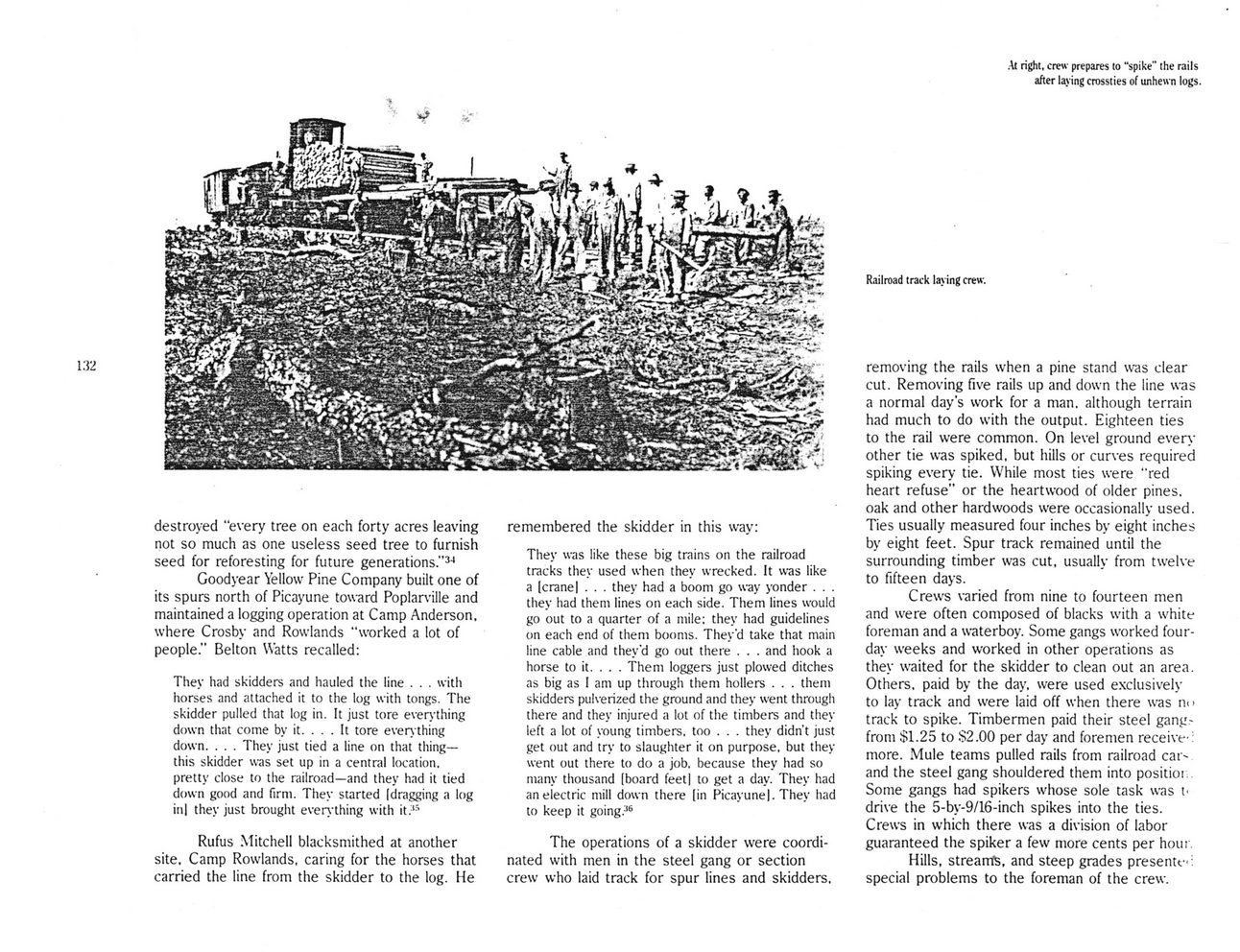This text was obtained via automated optical character recognition.
It has not been edited and may therefore contain several errors.
.At right, crew prepares to ?spike" the rails after laying crossties of unhewn logs. destroyed ?every tree on each forty acres leaving not so much as one useless seed tree to furnish seed for reforesting for future generations.?3-4 Goodyear Yellow Pine Company built one of its spurs north of Picayune toward Poplarville and maintained a logging operation at Camp Anderson, where Crosby and Rowlands ?worked a lot of people." Belton Watts recalled: They had skidders and hauled the line . . . with horses and attached it to the log with tongs. The skidder pulled that log in. It just tore everything down that come by it. . . . It tore everything down. . . . They just tied a line on that thing? this skidder was set up in a central location, pretty close to the railroad?and they had it tied down good and firm. They started [dragging a log ini they just brought everything with it.-15 Rufus Mitchell blacksmithed at another site. Camp Rowlands, caring for the horses that carried the line from the skidder to the log. He remembered the skidder in this way: They was like these big trains on the railroad tracks they used when they wrecked. It was like a [crane] . . . they had a boom go way yonder . . . they had them lines on each side. Them lines would go out to a quarter of a mile: they had guidelines on each end of them booms. They'd take that main line cable and they'd go out there . . . and hook a horse to it. . . . Them loggers just plowed ditches as big as I am up through them hollers . . . them skidders pulverized the ground and they went through there and they injured a lot of the timbers and they left a lot of young timbers, too . . . they didn?t just get out and try to slaughter it on purpose, but they went out there to do a job. because they had so many thousand [board feet| to get a day. They had an electric mill down there [in Picayune|. They had to keep it going.:l6 The operations of a skidder were coordinated with men in the steel gang or section crew who laid track for spur lines and skidders, Railroad track laying crew. removing the rails when a pine stand was clear cut. Removing five rails up and down the line was a normal day's work for a man. although terrain had much to do with the output. Eighteen ties to the rail were common. On level ground every other tie was spiked, but hills or curves required spiking every tie. While most ties were ?red heart refuse" or the heartwood of older pines, oak and other hardwoods were occasionally used. Ties usually measured four inches by eight inches by eight feet. Spur track remained until the surrounding timber was cut, usually from twelve to fifteen days. Crews varied from nine to fourteen men and were often composed of blacks with a white foreman and a waterboy. Some gangs worked four-day weeks and worked in other operations as they waited for the skidder to clean out an area. Others, paid by the day. were used exclusively to lay track and were laid off when there was no track to spike. Timbermen paid their steel gang^ from $1.25 to S2.00 per day and foremen receive-: more. Mule teams pulled rails from railroad car-and the steel gang shouldered them into position Some gangs had spikers whose sole task was t< drive the 5-by-9/16-inch spikes into the ties. Crews in which there was a division of labor guaranteed the spiker a few more cents per hour. Hills, streams, and steep grades presente :. special problems to the foreman of the crew.

Claiborne, J.F.H Claiborne-J.F.H-098